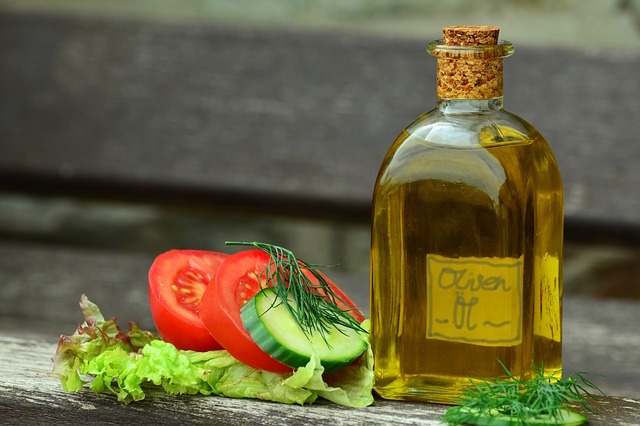
Commercial grades
The grades of oil extracted from the olive fruit can be classified as:
- Virgin means the oil was produced by the use of physical means and no chemical treatment. The term virgin oil referring to production is different from Virgin Oil on a retail label (see next section).
- Refined means that the oil has been chemically treated to neutralize strong tastes (characterized as defects) and neutralize the acid content (free fatty acids). Refined oil is commonly regarded as lower quality than virgin oil; the retail labels extra-virgin olive oil and virgin olive oil cannot contain any refined oil.
- Pomace olive oil means oil extracted from the pomace using chemical solvents, mostly hexane, and by heat.
Quantitative analysis can determine the oil’s acidity, defined as the percent, measured by weight, of free oleic acid it contains. This is a measure of the oil’s chemical degradation; as the oil degrades, more fatty acids are freed from the glycerides, increasing the level of free acidity and thereby increasing rancidity. Another measure of the oil’s chemical degradation is the organic peroxide level, which measures the degree to which the oil is oxidized, another cause of rancidity.
In order to classify it by taste, olive oil is subjectively judged by a panel of professional tasters in a blind taste test. This is also called its organoleptic quality.
Retail grades in IOOC member nations
In countries which adhere to the standards of the IOOC the labels in stores show an oil’s grade. The US is not a member.
- Extra-virgin olive oil comes from virgin oil production only, contains no more than 0.8% acidity, and is judged to have a superior taste. Extra Virgin olive oil accounts for less than 10% of oil in many producing countries. Used on salads, added at the table to soups and stews and for dipping.
- Virgin olive oil comes from virgin oil production only, has an acidity less than 2%, and is judged to have a good taste.
- Pure olive oil. Oils labeled as Pure olive oil or Olive oil are usually a blend of refined and virgin production oil.
- Olive oil is a blend of virgin and refined production oil, of no more than 1.5% acidity. It commonly lacks a strong flavor.
- Olive-pomace oil is refined pomace olive production oil possibly blended with some virgin production oil. It is fit for consumption, but may not be described simply as olive oil. Olive-pomace oil is rarely sold at retail; it is often used for certain kinds of cooking in restaurants.
- Lampante oil is olive oil not suitable as food; lampante comes from olive oil’s long-standing use in oil-burning lamps. Lampante oil is mostly used in the industrial market.
- Refined olive oil is the olive oil obtained from virgin olive oils by refining methods which do not lead to alterations in the initial glyceridic structure. It has a free acidity, expressed as oleic acid, of not more than 0.3 grams per 100 grams (0.3%) and its other characteristics correspond to those fixed for this category in this standard. This is obtained by refining virgin olive oils which have a high acidity level and/or organoleptic defects which are eliminated after refining. Over 50% of the oil produced in the Mediterranean area is of such poor quality that it must be refined to produce an edible product. Note that no solvents have been used to extract the oil but it has been refined with the use of charcoal and other chemical and physical filters. An obsolete equivalent is “pure olive oil”
Retail grades in the United States from the USDA
As the United States is not a member, the IOOC retail grades have no legal meaning in that country; terms such as “extra virgin” may be used without legal restrictions.
The U.S. Department of Agriculture (USDA) currently lists four grades of olive oil. These grades were established in 1948, and are based on acidity, absence of defects, odor and flavor:
- U.S. Grade A or U.S. Fancy possesses a free fatty acid content of not more than 1.4% and is “free from defects”;
- U.S. Grade B or U.S. Choice possesses a free fatty acid content of not more than 2.5% and is “reasonably free from defects”;
- U.S. Grade C or U.S. Standard possesses a free fatty acid content of not more than 3.0% and is “fairly free from defects”;
- U.S. Grade D or U.S. Substandard possesses a free fatty acid content greater than 3.0% and “fails to meet the requirements of U.S. Grade C”.
These grades are entirely voluntary and are available from the USDA on a fee-for-service basis.





